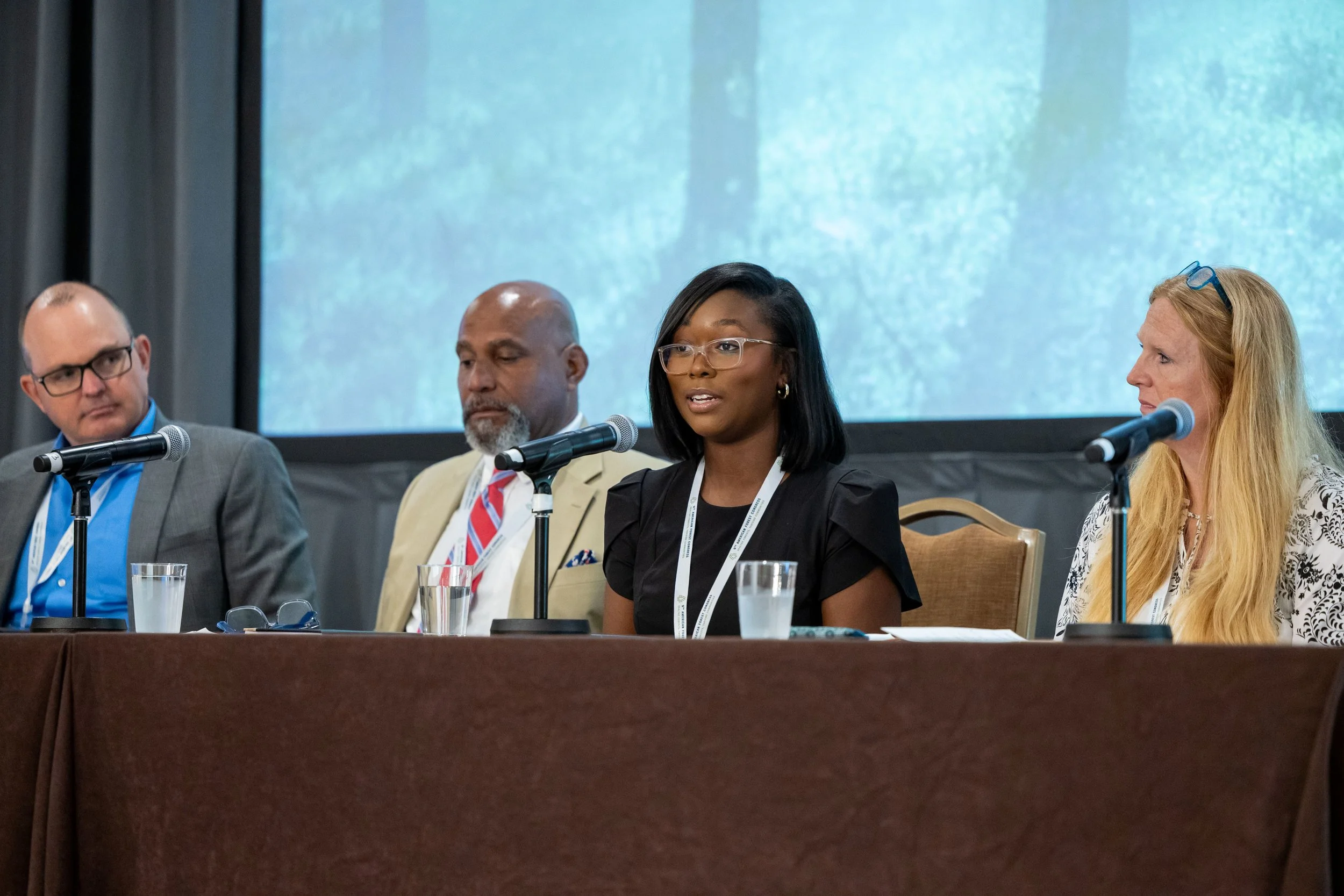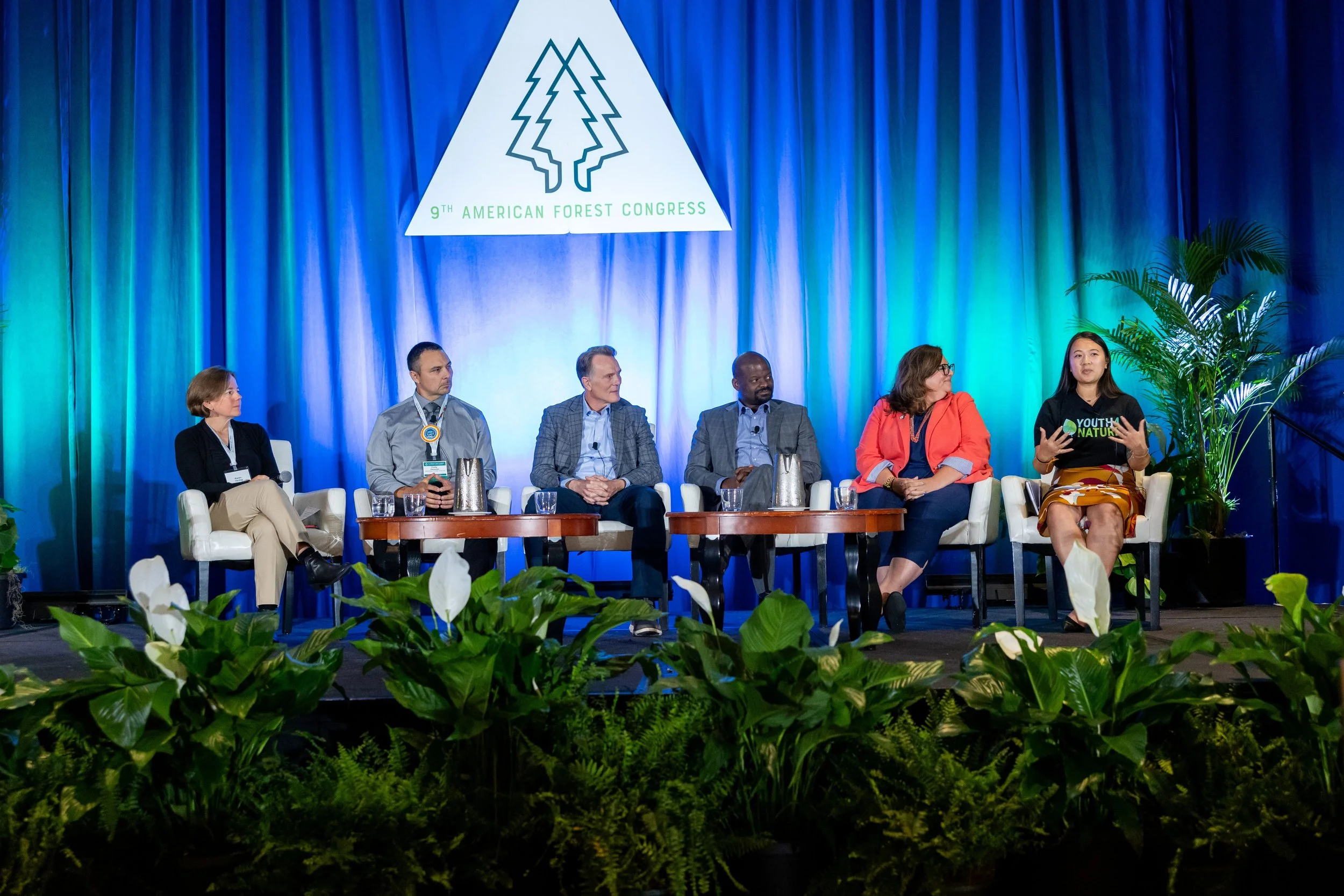Written by Samiksha Mukherjee | Edited by: Vinamra Mathur, Jennifer Hong | Photos: 9th American Forest Congress
The American Forest Congress has long stood as a flagship moment for the country’s forest community, offering space to look both forward and back at the movement and how far it’s come. From the founding of the U.S. Forest Service to elevating community-led forestry and gender equity with the creation of the Women’s Forest Congress, this Congress wasn’t just a regular networking event, but rather an intergenerational, communal ground.
As an emerging young professional and freshly graduated student, I was honored to attend the 9th American Forest Congress in Washington, D.C. alongside almost 500 leaders, practitioners, professionals, storytellers, and community-builders working to shape the path forward in the field of forest stewardship and conservation. The Congress theme this year was “Healthy Forests, Thriving Communities,” and was held from June 15th-18th, 2025. It focused on co-creating a shared vision for forest stewardship rooted in equity, science, and community. Forests were the focal point of the Congress and were highlighted throughout the event for the multitude of ecosystem services and values they bring to our lives. Through many insightful keynotes, workshops, storytelling circles, and formal voting on resolutions, the Congress gave us space to reflect not just on policy but also on people: how we build trust, transition leadership across generations, and care for forests like family.
In this blog, I dive into a snapshot of the key takeaways I learned, along with some reflections on how youth can show up in these spaces, whether you’re just starting out, trying to find your voice, or searching for a sense of belonging in the forest sector (e.g., conservation, like me!).
~~~
Nalini Nadkarni: Nature, Memory, and the Power of Disturbance
American forest ecologist Nalini Nadkarni opened the Congress with an incredibly deep, personal, and riveting keynote. Her work on forest disturbance and relic trees (those growing far apart from others) reminded us that nature, like people, thrives in community.
She spoke of forests as a tapestry, each species and structure in an ecosystem is a thread in a greater weave. We left reminded that knowledge doesn’t come from one source alone. Science, storytelling, and lived experience all shape how we understand and care for the land. Connect your values to your interests to things you’re not interested in. It will keep you passionate and engaged with things you didn’t consider before.
She also mentioned a fun fact: when measured out and calculated, the collective distance of tree branches swaying in the wind is enough to circle the equator of the Earth 7 times over in one year! This got me thinking: if we emulate nature and choose to take inspiration from it, then even your everyday tree can be a shining example of how even the smallest actions towards progress build up over time.
One overarching theme she spoke of often was that it’s vital to seek knowledge from different sources and diversify your ways of knowing, in order to broaden your horizons and scope of ideas. Being stuck in the same mindset and repertoire of facts doesn’t build progress; it simply forges a singular, unyielding path blind to others’ perspectives. It's clear that forests and people need networks and community to thrive, and it takes diversity and inclusion to get there.
~~~
The Importance of Governing by Leadership, Not Crisis
At the plenary sessions, it became clear that the forest sector is at a crossroads. From wildfire to weakening markets, forests face mounting threats… and yet, there’s a sense of possibility, of hope.
Speakers such as Representatives and Senators emphasized:
The importance of decentralizing decision-making: we shouldn’t let the power of choice and our futures consolidate to a few entities.
Grounding forest stewardship in reciprocity and the 7 Generation Principle: the things we do and actions we take now should benefit humans 7 generations down the line.
Acknowledging that “governing by crisis” isn’t sustainable, and must give way to proactive, community-based leadership.
A particularly powerful moment came when Indigenous perspectives on stewardship were uplifted as more than alternatives: they were positioned as foundational. A shift toward recognizing and actively integrating diverse epistemologies is one we hope becomes more than symbolic.
Calls to action:
Support federal forest workers and scientific infrastructure (e.g., Remote sensing technology for carbon capture, forest health monitoring programs, etc.)
Resist the “illusion of continuity”: old structures won’t serve future needs unless they evolve.
Educate others from the ground up! Connection builds communities who care 💚
~~~
Storytelling as Stewardship
On Wednesday, an insightful discussion on storytelling and outreach reminded us that facts alone don’t move people—stories do.
We discussed how to make data personal while still maintaining data sovereignty and boundaries, how to meet audiences where they are, and how digital tools can both broaden reach and build intimacy. Whether through protest, art, or social media, storytelling isn’t just about getting a message across; it’s about welcoming others into a community, making them feel seen/heard, and acknowledging capacities for growth, all while democratizing knowledge and making the message more accessible and understandable.
Tips taken to heart:
Be intentional: Know your audience and platform.
Connect unfamiliar issues to familiar values; people are dealing with their own issues, and they need an incentive to care.
Balance truth with hope! It’s important to show success stories as well as the challenges.
Storytelling is always, always more powerful in a community.
~~~
Cultivating Youth Talent: Intergenerational Dialogue
Youth4Nature hosted a discussion session on Thursday, where the Congress made space for honest discussion on the challenges youth face in entering and staying in the forest workforce.
From hiring practices to mentorship gaps, the message was clear: you can’t be what you can’t see. Representation, visibility, and trust-building across generations are essential to retaining young professionals in forestry careers.
What was heard:
Youth want purpose and stability—these aren’t mutually exclusive.
Job descriptions often don’t reflect reality, and adaptability is a crucial trait to have.
Community isn’t built through transactional relationships; it’s built through consistency and care.
As Terry Baker, the CEO of the Society of American Foresters said, “You [the youth] are not the future of the field, you are the present.”
~~~
A New Faces of Forestry Series - Thriving Communities x Forests
While all this was happening, Youth4Nature was also working on the sidelines to speak to young professionals working in forestry and forest-related sectors, asking them “What is your dream for forests in America in the next five years?” Their answers are inspiring, personal, and full of imagination. Y4N is launching a short film that brings their voices together—showing how the future of forests is being shaped by those stepping into leadership today. Filmed by Vishal Subramanyan, NatGeo Young Explorer, and edited by Maria Cecilia Mena.
The Final Voting Session: Collective Vision, Practical Action
On the final day, participants voted on the final principles and resolutions that will guide national forest stewardship in the United States moving forward. A collaborative, facilitated process that occurred live, all participants worked throughout the duration of the Congress to build, draft, refine, and finally vote on the key ideas and messages that would help drive the future of forestry. Each principle and resolution was carefully constructed, including the voices of everyone who contributed, which gave youth at the Congress a real opportunity to shape what comes next. It meant that youth voices were counted in decisions that will influence national forest policies, funding priorities, and cross-sector partnerships for years to come. We aren’t just observers, we are changemakers.
There was momentum in the voting process, but also a clear theme of accountability: Are we building something future generations will be proud of?
Some central questions emerged from this last session:
How do we make capitalism work for conservation, not against it?
Can our forest economy be one that honors care and reciprocity?
How do we ensure our progress is shared and felt at every level: not just in high-level resolutions, but in forests, towns, and individual communities and lives?
The Congress ended with hope, but not naïveté. We kept returning to the metaphor of forests as networks: not just ecological ones, but human ones too. Whether through Nalini Nadkarni’s keynote or the many vulnerable discussions about the realities of the field, we were reminded consistently that forests aren’t just about trees or policies. They are about people. They’re about connection. And if there was one takeaway to be made throughout the event, it was this: We must act as if the future is already watching.
And as youth, our role is not to wait for a turn at the table—it’s to co-create the table ourselves.





